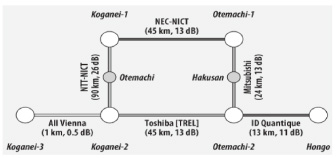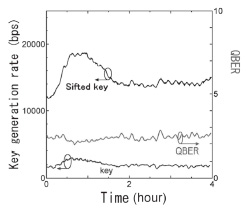Optical Science Laboratory
NTT, NEC, and Mitsubishi electric, which are funded by NICT, developed
each of their Quantum Key Distribution (QKD) system, and connected in Tokyo
these systems as well as QKD systems brought by AIT, Id quantique, Toshiba
Research Europe, which forms Tokyo QKD Network.
QKD is a way to distribute the so-called key. The key is a random bit string whose information is not leaked to unauthorized parties, and the key is used for authorized parties to communicate each other without leakage of its information. In order to prevent eavesdropping, QKD employs the fact that no one can be against the law of nature, including the so-called quantum mechanics. More attentions have been paid to this cryptography which is unbreakable given the users' devices operate as the theory imposes.
Tokyo QKD network consists of six nodes over the optical communication
testbed network, JGN2plus (Fig. 1), and two of the nodes can generate the
key being fast enough for the live transfer of a video data. NTT was in
charge of the longest link of 90 km between Koganei and Otemachi and back,
and we have successfully realized 2 kbps of the key generation rate. We
have developed a system for the Differential Phase Shift QKD (DPS-QKD)
[1], which was proposed jointly by NTT and Stanford University. This protocol
features its simplicity of the system configuration, and thus it is easy
to be implemented. We have used Field-Programmable Gate Array for high-speed
random number generation with 1GHz clock, fast signal generation, and fast
memory access, and also we have implemented polarization feed-back controller
to eliminate the polarization dependency of superconducting single photon
detectors developed by NICT. This system outputs the "sifted key",
from which the key to be used over the optical network is distilled via
some data processing by the key distillation engine developed by NEC.
Thanks to these attempts for the stabilization and speeding-up, we have
achieved stable generation of the sifted key over 8 days with about 18
kbps of the generation rate as well as 2 kbps of the secure key generation
rate (Fig. 2) [2].
This work was in part supported by NICT.
[1] K. Inoue et al., Phys. Rev. A 68 (2003) 022317.
[2] M. Sasaki et al., Opt. Express 19 (2011) 10387.
 |
 |
|||||
|
|